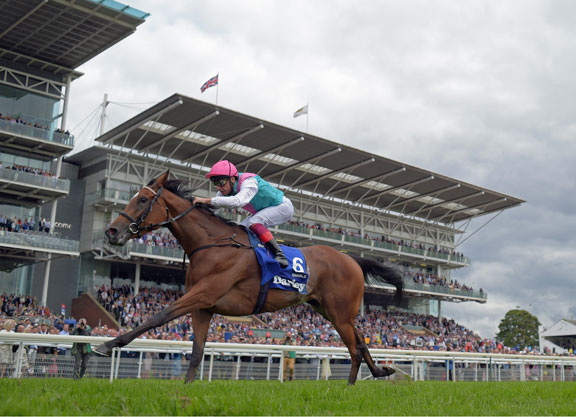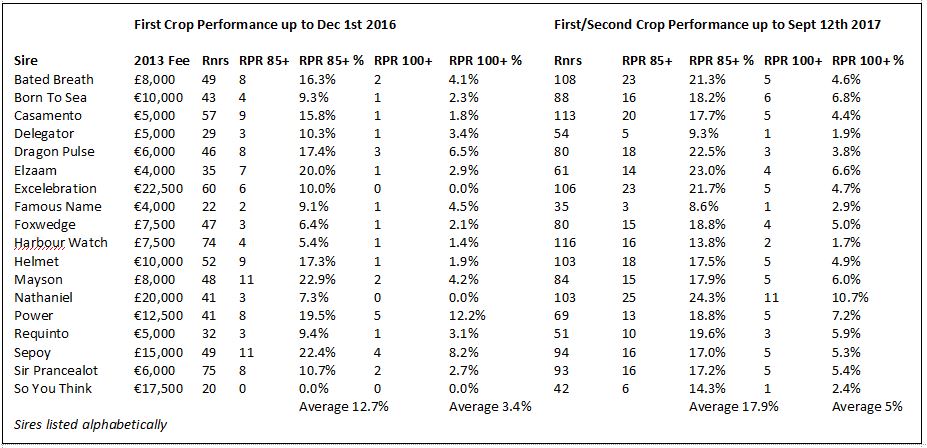By Kevin Blake
Anyone that has been involved in the world of bloodstock knows just how incredibly fickle and unforgiving a game it can be. Sires comes in and out of fashion at a quite frightening pace and there is no more brutal example of this than first-season sires. No matter what their profile or circumstances, many industry participants are very comfortable with writing off a stallion based on the performance of their first 2-year-old runners.
This eagerness to make quick judgments results in a great amount of focus on the first-season sire table every year. However, not nearly as much attention is paid to the table of second-crop sires. Yet, it is this table that can reveal even more valuable information to the discerning observer. It can often reveal that some of the conclusions drawn by the market based on the first-season sire table were overly hasty, identifying sires that are undervalued by the market and thus whose progeny have a strong statistical chance of representing value for money at the upcoming yearling and foal sales.
The second-crop sires of 2017 are made up of a larger-than-average group of 19 sires based in Great Britain and Ireland that had 50 or more live foals in their first crops. Inevitably, the most talked about sire amongst the group has been Frankel (GB), but I have not included his statistics in the below table, as he is essentially in a category of his own with his nomination fee being so much greater than his 18 rivals. His performance will be analysed in detail in this space later this season.
The remaining 18 sires have been assessed using the measure of Racing Post Ratings. All of the statistics relate to runners in Europe and are accurate up to Sept. 12. As a means to assess how each sire has progressed since last year, I have included the statistics that each sire registered with their first 2-year-olds up to Dec. 3, 2016.
Some of these results are sure to surprise many. As previously mentioned, many in the bloodstock business are very comfortable in making quick judgements of sires and it is an unfortunate feature of human nature that many will be reluctant to acknowledge misjudgements even when the evidence is overwhelming. Thus, some of those sires that have really come forward in the last nine months or so have done so without getting the plaudits they have earned, but they will get them here.
Of course, the headline act in terms of improvers, one which even the most stubborn of observers cannot fail to acknowledge, is Nathaniel (Ire) (Newsells Park). Expectations were very high for the son of Galileo after he was well supported by breeders and the resulting stock were very well received at the yearling sales, but even considering that his progeny were expected to make up into better 3-year-olds, the performance of his first 2-year-olds was quite frankly abject. From 41 runners, just three of them squeaked past an RPR of 85.
However, the transformation in their fortunes this year has been incredible to witness. While the brilliant four-time Group 1 winner Enable (GB) has very much led the way for him, it has been anything but a one-horse show as the above statistics show. For him to improve from the very bottom end of the rankings for percentage of RPR85+ and RPR100+ performers with his 2-year-olds to the top position in both categories this year is simply sensational. It is a comeback story to rival any that Rocky Balboa ever pulled off and is certainly the most remarkable such case that I can recall in my time analysing sires.
Excelebration (Ire) (Coolmore) is another second-crop sire that has been fortunate to have a very high-profile representative to fly his flag in the shape of the G1 St James's Palace S. winner Barney Roy (Ire), but it hasn't been a one-horse show for him either, with his progeny making solid progress this season. While he registered below-average RPR85+ figures with his 2-year-olds, that percentage has more than doubled this season to take him above the average. Just as importantly, having had no RPR100+ performer amongst his 2-year-old runners, he now has five of them which brings him close to the average rate across this sample.
While both of those sires had the glorious luxury of a Group 1 winner to advertise their prowess, one that hasn't had such a performer but has been quietly making serious progress is Born To Sea (Ire) (Gilltown). The son of Invincible Spirit (Ire) was considered by some to be in big trouble after his first 2-year-olds failed to set the world alight in 2016, but in common with his half-brothers Galileo (Ire) and Sea The Stars (Ire), it has been in his second year with runners that he has really come good. His percentage of RPR85+ performers has doubled and his percentage of RPR100+ performers has tripled, leaving him with above-average rates in both categories. Given that he hasn't had a flagship performer to put his name up in lights, it will be interesting to see if the significant improvement that his progeny have made will be acknowledged by the buyers at the upcoming sales.
While the above analysis relates solely to the performances of the progeny of the sires in question, it is also important not to lose sight of expectation based on the quality of mares they received, which in this case can be contextualised by the fee they stood for in their first season. With that in mind, there are a number of sires that stood right at the bottom end of the nomination scale whose performance very much warrant plaudits.
Elzaam (Aus) (Ballyhane) made a very good start with his first 2-year-olds and not only has he maintained that performance this year, he has built on it. Considering he stood for a very low fee in his first few years at stud, that he has the second-highest percentage of RPR85+ performers and the fourth-highest RPR100+ percentage amongst these 18 sires marks him out as a stallion that upgrades his mares. It will be fascinating to see what he achieves in years to come when paired with higher-quality mates.
Sir Prancealot (Ire) (Tally Ho) was very quick out of the blocks with his 2-year-olds last season and given that he himself had been retired at the conclusion of his juvenile campaign, the obvious concern was how well his progeny would train on. However, the performances of his 3-year-olds this year have dispelled such concerns and indeed, his overall numbers have taken a notable upturn in that time, with him making solid gains in the RPR85+ field and securing an above-average RPR100+ rate.
One that didn't set the world alight with his first 2-year-olds in Europe that has taken a very solid step in the right direction this year is Foxwedge (Aus) (Whitsbury Manor). While he had some reputational insulation via the solid performance of his first runners in Australia, for his European runners to have tripled their RPR85+ rate and doubled their RPR100+ rate this year is a significant positive for him
While Requinto (Ire) (Coolmore) has one of the smallest number of runners of all the sires examined, the performance of the small sample of his progeny is good enough to warrant mention, with his RPR85+ and RPR100+ percentages having doubled to above-average rates this year. He is one to keep an eye on going forward.
Not a subscriber? Click here to sign up for the daily PDF or alerts.







